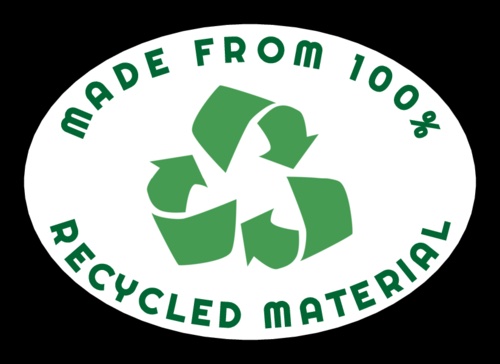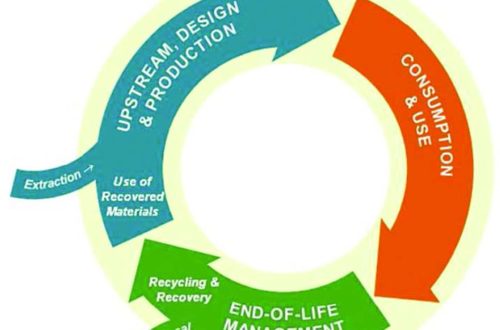Put the “Cycle” in Recycle
Let’s say you’re at an office supply store shopping for copy paper. You locate a ream, and the label says it’s Recycled paper. “That’s great!” you think. “This must be made from the waste paper I put in my recycling bin at home!” Right?
Nope.
Or at least not likely. The paper you’re holding was indeed made from recycled material. But it was sourced from mill broke, aka “trimmings,” or the scraps left over from the paper manufacturing process. This isn’t a new thing; recycling “Pre-Consumer” material has been a conventional practice practically since paper was invented.
A product label could also say it’s Recycled when it contains “Post-Industrial” recycled content. This, for example, is when a manufacturer contributes finished but unused plastic milk jugs for recycling. Processors are partial to Post-Industrial material because it arrives presorted and uncontaminated. In the case of the milk jugs, they also have a uniform size and shape and are made with the same type of plastic.
It’s good that Pre-Consumer and Post-Industrial material is diverted from the landfill. But where is the material we put in our home recycling bins?
When our recycling bin contributions are processed and manufactured into new products, the label can also say it’s Recycled. But it would be more accurate and good marketing to explain that it contains “Post-Consumer Recycled” or PCR material. However, finding products made with a high percentage of PCR content can be challenging. Even though more than enough waste is available for recycling, processors require clean material. Sadly, what consumers place in their recycling bins is often too contaminated to use. If people don’t sort properly or add soiled items to the recycling stream, an entire batch could be rendered unusable. Your recycling bin should only contain items that are clean, dry, sorted, and, most importantly, accepted by your recycler.
But that’s just the first step. Next, we need to buy the products made from the materials we contributed. It’s called “Closing the Loop.”
Contributing to a circular economy isn’t the only reason to buy products made with PCR content. By not using raw or virgin materials, it preserves natural resources. In addition, our purchases support the recycling industry, which includes haulers, processors, manufacturers, and retailers. They need to make a profit to stay in business.
We all want to do the right thing by recycling. Just remember to stick to the recycling rules, and next time you’re shopping, look for products with a high PCR content. Let’s put the “cycle” in recycle.
When shopping in the circular economy, pay attention to the Post-Consumer Recycled material content claims. Because the wording can be misleading, if not a flat out lie.
If you see a product that says it made with PCR material, try to find out the percentage of the PCR content. It doesn’t have to be made from 100% PCR; any percentage is helpful. But be aware of labels that don’t provide the percentage of the PCR content. Sometimes you’ll see a label say the product is made from “up to” a PCR content percentage. That could mean it contains just 1%. You might also come across a promising “minimum of” PCR content, which is more straightforward, but implies that the PCR content fluctuates.
Here’s a list of some products whose label claims a high percentage of PCR content.
Trash bags:
Some people eschew purchasing trash bags because they’re made with virgin plastic. Not only are they used once then thrown away, they also don’t help to reduce plastic.
However, trash bags keep items contained so nothing blows away when being hauled. A visit to the Waste Management landfill will demonstrate why containing garbage is a good thing. The landfill serving the greater Portland area is located in Arlington, Oregon. Since it’s on the Colombia River, high winds blow loose trash into the surrounding chain link fences. The fences are now solid with garbage and there’s no telling how much garbage (now litter) made it over the top.
Beyond addressing that problem, buying trash bags made with PCR content stimulates the circular economy.
Copy paper:
Toilet paper:
Seventh Generation Bath Tissue
Dog poo bags:
Don’t waste your money on biodegradable poop bags. You don’t want a poop bag to break down in either the landfill releasing methane. And never put it in the Yard Debris with your food waste because the compost will be use on consumable vegetation. Parasites and bacteria can live in dog waste, including E. coli. More on this in future articles.
Clothing:
A lot of the clothing sold by Patagonia is made with PCR content.
Liquid soap:
Dr. Bronners Soap Switching to bar soap is even better!
Camping and beach goods:
PCR-containing products may cost more. However minimizing the use of virgin materials in product manufacturing and packaging, not to mention the garbage created, is worth the price.

Cecelia Warner lives in Forest Grove and is a Master Recycler. She leads the campaign, Shake & Fold: Preventing Paper Towel Waste to Help Curb Climate Change. shakeandfold.org
She founded a durable dinnerware program at the Forest Grove Farmers Market’s Waste Center. Since 2011, over 25,500 plates have been washed and reused, diverting paper ones from the landfill. The program offers washable utensils and cloth napkins.
She’s also the organizer of the Forest Grove Trash Bash every September. It includes a Sustainability Fair, a Litter Pick Up event, and a Trashion Show. forestgrovetrashbash.org
Cecelia and her spouse walk or bike everywhere they can, though they own an electric car.






